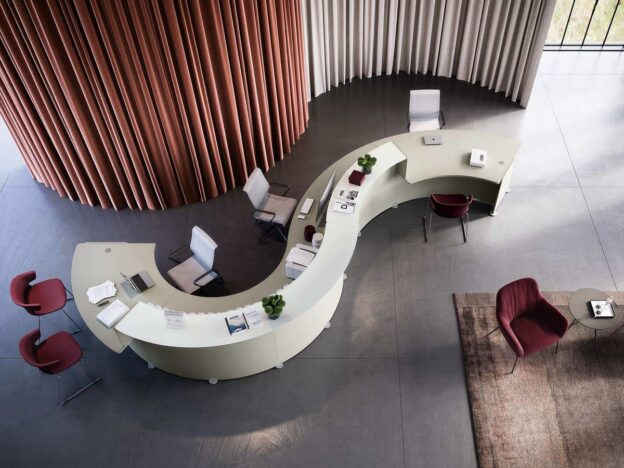When you step into an office, what’s the first thing that catches your eye? Is it the vibrant buzz of productivity, the sleek lines of modern architecture, or perhaps the inviting warmth of the reception area? While all these elements contribute to the overall feel of an office, there’s an often-overlooked hero in setting the tone: reception furniture. This seemingly minor detail plays a pivotal role in creating a lasting first impression and influencing the office atmosphere.
The First Impressions Are Lasting Ones
In business, first impressions are critical. The reception area serves as the face of the company, providing the first physical interaction for clients, partners, and potential employees. It’s here that reception furniture steps into the spotlight. A well-designed reception desk, comfortable seating, and thoughtful decor communicate volumes about a company’s values and culture. Are you greeted by a sleek, minimalist desk paired with contemporary seating, suggesting innovation and forward-thinking? Or perhaps a plush, traditional arrangement that exudes stability and professionalism?
The Subtle Art of Comfort and Welcoming Design
Reception furniture is more than just aesthetics. Comfort is key. After all, guests may spend several minutes waiting, and those minutes can shape their perception of your business. Ergonomically designed chairs with adequate support, complemented by a welcoming ambiance, show that the company values its visitors’ comfort and well-being.
Consider the placement and variety of seating. A mix of single chairs and communal sofas can cater to different preferences, making the space feel inclusive. Thoughtful touches, such as easily accessible charging stations and coffee tables with current magazines, can enhance the experience, making guests feel considered and at ease.
Branding Through Furniture
Reception furniture also offers a unique opportunity to reinforce your brand identity. Custom-designed furniture featuring company colors, logos, or motifs can subtly reiterate your brand’s message. For instance, a tech startup might choose sleek, modular furniture to reflect its cutting-edge nature, while a law firm might opt for more classic, robust pieces to signify reliability and tradition.
The Psychological Impact
The psychology of space is a fascinating field that shows how our environment influences our mood and behavior. Reception areas are no exception. A cluttered, uncomfortable, or poorly lit reception area can subconsciously induce stress or impatience in visitors. Conversely, a well-organized, aesthetically pleasing space can promote calmness and positivity. Natural light, plants, and artwork can further enhance this effect, creating a serene environment that sets a positive tone for any interaction that follows.
Practical Considerations
Beyond aesthetics and comfort, reception furniture must be practical and functional. Durability is crucial, as this area experiences high traffic. Easy-to-clean materials ensure that the space remains pristine and inviting despite heavy use. Additionally, the layout should allow for easy navigation and accessibility, ensuring a seamless experience for all visitors, including those with disabilities.
Reflecting Company Culture
Finally, the reception area, and by extension, its furniture, is a reflection of company culture. An open, inviting space with casual seating can convey a relaxed, innovative atmosphere. In contrast, a more formal, structured setup might reflect a company that values tradition and formality. By aligning the reception area with the broader office culture, companies can create a cohesive and authentic first impression.
Conclusion
Reception furniture is far more than an afterthought in office design. It’s a critical element that shapes first impressions, reflects brand identity, and influences the overall atmosphere of an office. By investing in thoughtful, well-designed reception furniture, businesses can create a welcoming, professional, and memorable experience for every visitor who walks through their doors. Remember, in the art of making first impressions, the furniture is front and center.
